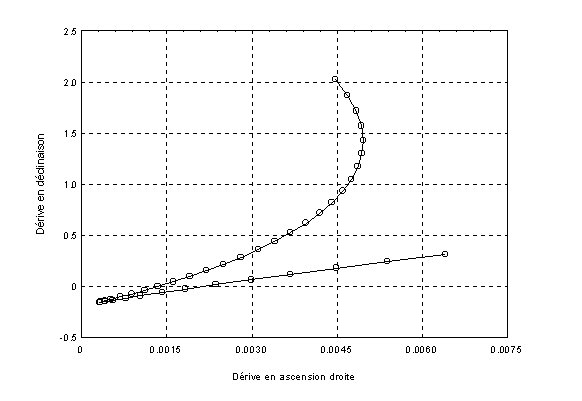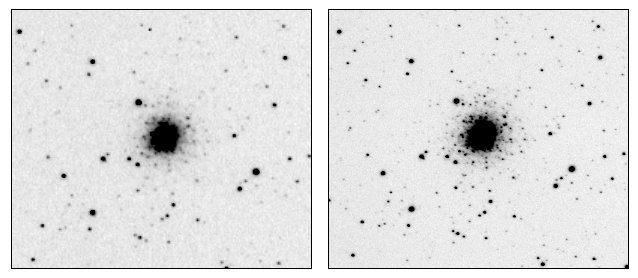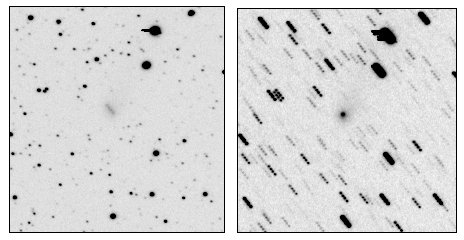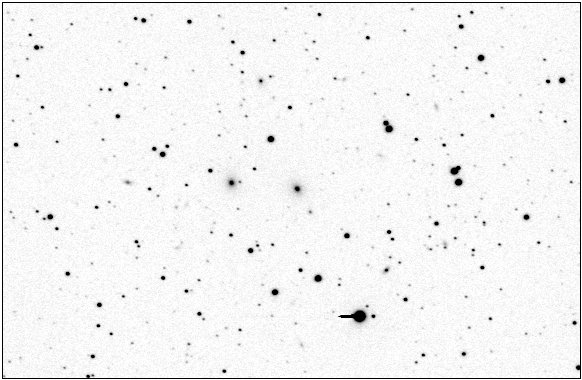THE DRIFT-SCAN TECHNIQUE
The "drift-scan" technique makes use of the movement
of stars at the focal plane of a telescope when its drive is switched off, to image long
continuous strips of the sky. Quite a big field can be explored almost automatically in this way.
In practice, to make a scan you have to read the lines of the CCD in
perfect synchronisation with the movement of the sky at the focal plane.
For example when, by taking in account the focal length of the telescope, the size of the pixels and the declination pointed at, a star takes 0.4 seconds to pass from one line of the CCD to the next, the lines
of the CCD should be read at a pace of exactly one line every 0.4 seconds. It is also important
to perfectly align the columns of the CCD with the east-west movement of the sky. The exposure
time is the time it takes an object to move across the CCD from one side to the other.
The drift-scan technique is rather magical because you can obtain images by the kilometre without moving the telescope at all. Drift-scan is particularly effective in the scope of surveillance programs (surveys), for example for finding comets or asteroids.
A typical configuration for drift-scan. A Canon EF 300 mm F/4 telephoto lens is mounted
on the front plate of an Audine camera (a prototype model with adhesive tape around its plastic body).
In the right image we see how the camera is mounted on a micrometer rotation plate, very useful
to orient the columns of the CCD parallel with the diurnal movement. Note how the objective is pointed towards the celestial equator, the favoured position for making a drift-scan. The equatorial mount is for support only; it is not driven during image acquisition.
 Scan image acquired with an Audine camera and a Canon EF 300 mm F/4 telephoto lens. The sky moves
from the left to the right. At the right we see a ramp corresponding with the start of the scan. The image has a height of 768 pixels and is 2800 pixels wide. The line scan time is 0.418 seconds, which gives a total acquisition time of 2800 x 0.418 = 1170 seconds, i.e. about 20 minutes. The exposure time is 512 x 0.418 = 214 seconds. The effectively covered field is (the ramp portion must be subtracted) 3.93 x 1.32°, i.e. about 5.2 square degrees.
Scan image acquired with an Audine camera and a Canon EF 300 mm F/4 telephoto lens. The sky moves
from the left to the right. At the right we see a ramp corresponding with the start of the scan. The image has a height of 768 pixels and is 2800 pixels wide. The line scan time is 0.418 seconds, which gives a total acquisition time of 2800 x 0.418 = 1170 seconds, i.e. about 20 minutes. The exposure time is 512 x 0.418 = 214 seconds. The effectively covered field is (the ramp portion must be subtracted) 3.93 x 1.32°, i.e. about 5.2 square degrees.
 Part of a scan made at the declination of the Andromeda galaxy (this field precedes the galaxy about 10 minutes in time, the sky moves from left to right). In other words: a central declination of +41°. At such a declination the difference in velocity between the centre of the field and the upper and lower parts is quite noticeable. In this direction and with this optical configuration the image is unusable except for a 0.3° band on both sides of the central declination. A small orientational error makes the situation even worse. Drift-scan, as practised here is not particularly usable except for declinations between +25° and -25 °, thus covering the ecliptic zone.
Part of a scan made at the declination of the Andromeda galaxy (this field precedes the galaxy about 10 minutes in time, the sky moves from left to right). In other words: a central declination of +41°. At such a declination the difference in velocity between the centre of the field and the upper and lower parts is quite noticeable. In this direction and with this optical configuration the image is unusable except for a 0.3° band on both sides of the central declination. A small orientational error makes the situation even worse. Drift-scan, as practised here is not particularly usable except for declinations between +25° and -25 °, thus covering the ecliptic zone.
 Numeric simulation of the deviation of a star in the instrumental configuration used to acquire the previous image. Between every point on the curve 10 seconds have elapsed. This type of analysis permits to determine with great precision the field that can be effectively covered, the impact of an alignment or velocity error, the corrections to make, ... The drift-scan technique with the Audine camera is the subject of rather challenging studies because this camera is very well adapted and the range of applications promising. At the moment the drift-scan mode of Audine is controlled by a special version of the QMiPS32 software.
Numeric simulation of the deviation of a star in the instrumental configuration used to acquire the previous image. Between every point on the curve 10 seconds have elapsed. This type of analysis permits to determine with great precision the field that can be effectively covered, the impact of an alignment or velocity error, the corrections to make, ... The drift-scan technique with the Audine camera is the subject of rather challenging studies because this camera is very well adapted and the range of applications promising. At the moment the drift-scan mode of Audine is controlled by a special version of the QMiPS32 software.
 The globular cluster M2 observed with the drift-scan technique. These images are the result of compositing 3 successive scans. On the left, with a Leitz Telit 200 mm F/4 telephoto lens and a BG18 filter. On the right, with a Canon EF 300 mm F/4 and KG3 filter. The image acquired with the 200 mm objective is enlarged to give it the same scale as the image taken with the 300 mm lens. The superiority of the latter in terms of resolution is evident, partly because of the longer focal length, and for the other part because of the better chromatic correction. The use of an KG3 rather than a BG18 filter improves the resolution considerably. On the other hand, the field covered by the 300 mm lens is much smaller.
The globular cluster M2 observed with the drift-scan technique. These images are the result of compositing 3 successive scans. On the left, with a Leitz Telit 200 mm F/4 telephoto lens and a BG18 filter. On the right, with a Canon EF 300 mm F/4 and KG3 filter. The image acquired with the 200 mm objective is enlarged to give it the same scale as the image taken with the 300 mm lens. The superiority of the latter in terms of resolution is evident, partly because of the longer focal length, and for the other part because of the better chromatic correction. The use of an KG3 rather than a BG18 filter improves the resolution considerably. On the other hand, the field covered by the 300 mm lens is much smaller.
 Comet C/1997 J2 (Meunier-Dupouy) observed in drift-scan mode at a declination of +20° with a 300 mm F/4 Canon EF telephoto lens. It consists of a composite of 4 scans, the time between the start of each scan is about 20 minutes. This amount of time is enough to detect evidence for movement of the comet against the background stars. On the right the 4 elementary images are registered on the stars, and on the left they are registered on the nucleus of the comet. The comets tail is clearly visible extending to the north. These images show it is perfectly possible to get good results at a considerable declination. Only a small portion of the scan is shown here, but the whole field (1.3° wide) is of practically the same quality.
Comet C/1997 J2 (Meunier-Dupouy) observed in drift-scan mode at a declination of +20° with a 300 mm F/4 Canon EF telephoto lens. It consists of a composite of 4 scans, the time between the start of each scan is about 20 minutes. This amount of time is enough to detect evidence for movement of the comet against the background stars. On the right the 4 elementary images are registered on the stars, and on the left they are registered on the nucleus of the comet. The comets tail is clearly visible extending to the north. These images show it is perfectly possible to get good results at a considerable declination. Only a small portion of the scan is shown here, but the whole field (1.3° wide) is of practically the same quality.
 Part of a scan that includes the field of galaxies surrounding NGC 7619. The modesty of the instrument used, a 300 mm telephoto lens, leaves little chance of discovering a supernova, although with a bit of perseverance and aiming at a region as densely populated as the Virgo Cluster…
The use of the drift-scan acquisition mode with Audine is actually possible in a special version of QMiPS32
(not yet available) and with a console command in Pisco.
Part of a scan that includes the field of galaxies surrounding NGC 7619. The modesty of the instrument used, a 300 mm telephoto lens, leaves little chance of discovering a supernova, although with a bit of perseverance and aiming at a region as densely populated as the Virgo Cluster…
The use of the drift-scan acquisition mode with Audine is actually possible in a special version of QMiPS32
(not yet available) and with a console command in Pisco.









